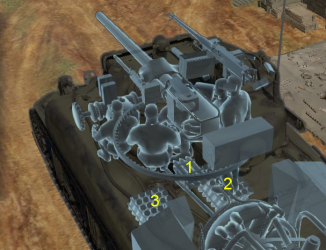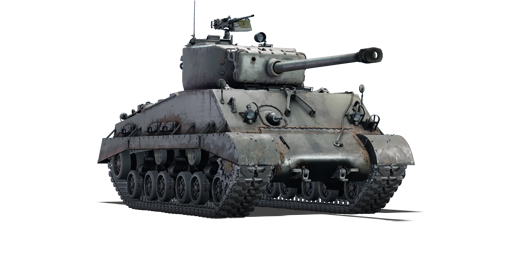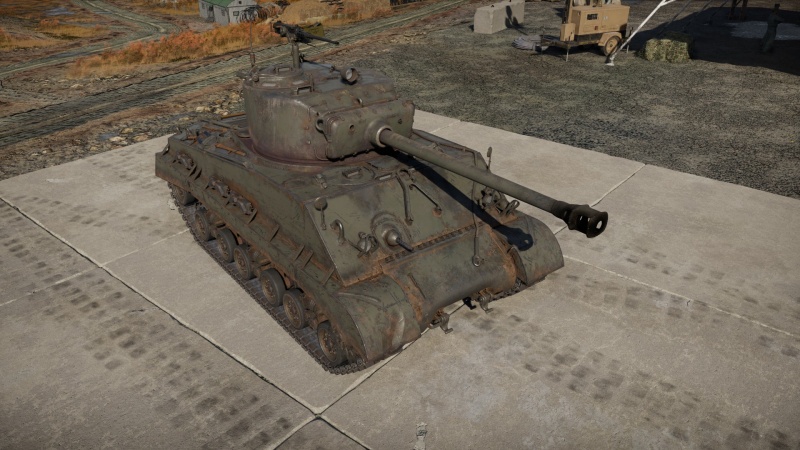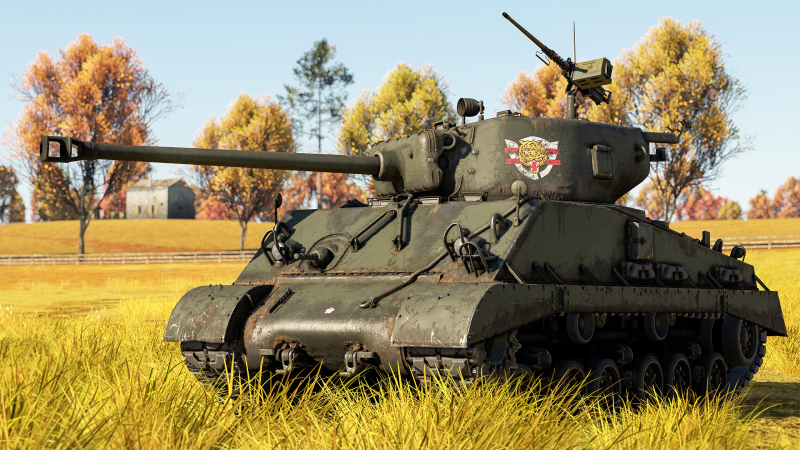Difference between revisions of "M4A3 (76) W (Japan)"
Colok76286 (talk | contribs) (→Ammo racks: Updated section) |
(→Main armament: Updated) |
||
| Line 67: | Line 67: | ||
|- | |- | ||
! ''Arcade'' | ! ''Arcade'' | ||
| − | | rowspan="2" | 71 || rowspan="2" | -10°/+25° || rowspan="2" | ±180° || rowspan="2" | {{Annotation|Vertical|up to 24 km/h}} || | + | | rowspan="2" | 71 || rowspan="2" | -10°/+25° || rowspan="2" | ±180° || rowspan="2" | {{Annotation|Vertical|up to 24 km/h}} || 20.0 || 27.7 || 33.6 || 37.2 || 39.5 || rowspan="2" | 7.67 || rowspan="2" | 6.78 || rowspan="2" | 6.25 || rowspan="2" | 5.90 |
|- | |- | ||
! ''Realistic'' | ! ''Realistic'' | ||
| − | | | + | | 12.5 || 14.7 || 17.9 || 19.7 || 21.0 |
|- | |- | ||
|} | |} | ||
| Line 80: | Line 80: | ||
! rowspan="2" data-sort-type="text" | Ammunition | ! rowspan="2" data-sort-type="text" | Ammunition | ||
! rowspan="2" | Type of<br>warhead | ! rowspan="2" | Type of<br>warhead | ||
| − | ! colspan="6" | | + | ! colspan="6" | Penetration @ 0° Angle of Attack (mm) |
|- | |- | ||
! 10 m !! 100 m !! 500 m !! 1,000 m !! 1,500 m !! 2,000 m | ! 10 m !! 100 m !! 500 m !! 1,000 m !! 1,500 m !! 2,000 m | ||
| Line 109: | Line 109: | ||
| M62 shell || APCBC || 792 || 7 || 1.2 || 14 || 63.7 || 48° || 63° || 71° | | M62 shell || APCBC || 792 || 7 || 1.2 || 14 || 63.7 || 48° || 63° || 71° | ||
|- | |- | ||
| − | | M42A1 shell || HE || | + | | M42A1 shell || HE || 823 || 5.84 || 0 || 0.1 || 390 || 79° || 80° || 81° |
|- | |- | ||
| M79 shot || AP || 792 || 6.8 || N/A || N/A || N/A || 47° || 60° || 65° | | M79 shot || AP || 792 || 6.8 || N/A || N/A || N/A || 47° || 60° || 65° | ||
| Line 176: | Line 176: | ||
== Usage in battles == | == Usage in battles == | ||
<!-- ''Describe the tactics of playing in the vehicle, the features of using vehicles in the team and advice on tactics. Refrain from creating a "guide" - do not impose a single point of view but instead give the reader food for thought. Describe the most dangerous enemies and give recommendations on fighting them. If necessary, note the specifics of the game in different modes (AB, RB, SB).'' --> | <!-- ''Describe the tactics of playing in the vehicle, the features of using vehicles in the team and advice on tactics. Refrain from creating a "guide" - do not impose a single point of view but instead give the reader food for thought. Describe the most dangerous enemies and give recommendations on fighting them. If necessary, note the specifics of the game in different modes (AB, RB, SB).'' --> | ||
| − | Playing as the M4A3 can be tricky since it features armour that can't stop most | + | Playing as the M4A3 can be tricky since it features armour that can't stop most calibres at its rank such as the German 8.8 cm or the Soviet 85 mm, including the fact that it isn't the fastest tank. The M4A3 plays more of a support role, use the powerful 76 mm to assist teammates during an advance or defense. The number one rule of this tank is to never fight alone with it, always be with a teammate and use cover when available since it will give the Sherman a great advantage. |
=== Pros and cons === | === Pros and cons === | ||
| Line 203: | Line 203: | ||
The [[M4|M4 Sherman]] has become a proven and well-respected tank design by 1944. It was highly reliable, adequately armoured, and could be produced in a very large number with a dedicated support arm to ensure that all of the ones in the field could be kept operational. It was also by 1944 that the Sherman's faults were becoming a more defining trait than its advantages, namely with the increased prevalence of German anti-tank weaponry and tanks, such as the [[Panther A|Panther]] tank. The German anti-tank abilities, ranging from rocket launchers, anti-tank guns, mines, and tank guns, all became more capable of penetrating the frontal armour or disabling the Sherman. This resulted in an increased Allied tank attrition rate of nearly double during the Normandy Campaign than that of the Allies' previous campaigns. Criticisms were raised on the Sherman's inability to destroy the heavier tanks with its [[M3 (75 mm)|75 mm gun]], the tendency of catching fire easily when a penetrating round hits an ammo stowage bin scattered in the Sherman interior, and the lack of mobility on the muddy terrain due to the track design. The first and second criticism was addressed with the [[M1 (76 mm)|high-velocity 76 mm gun]] and a "wet stowage" ammo containers, but mobility became a big issue especially once the Allied front in France reached the Siegfried Line on the border of Germany, where the ground became very muddy in the fall season. An attempt to fix this was improvising "extensions" on the tracks, but these were difficult to add and there were never enough to go around. The problem had to be addressed in the manufacturing plant and Ordnance Department set to work finding a better solution to fix the track flotation for better mobility. | The [[M4|M4 Sherman]] has become a proven and well-respected tank design by 1944. It was highly reliable, adequately armoured, and could be produced in a very large number with a dedicated support arm to ensure that all of the ones in the field could be kept operational. It was also by 1944 that the Sherman's faults were becoming a more defining trait than its advantages, namely with the increased prevalence of German anti-tank weaponry and tanks, such as the [[Panther A|Panther]] tank. The German anti-tank abilities, ranging from rocket launchers, anti-tank guns, mines, and tank guns, all became more capable of penetrating the frontal armour or disabling the Sherman. This resulted in an increased Allied tank attrition rate of nearly double during the Normandy Campaign than that of the Allies' previous campaigns. Criticisms were raised on the Sherman's inability to destroy the heavier tanks with its [[M3 (75 mm)|75 mm gun]], the tendency of catching fire easily when a penetrating round hits an ammo stowage bin scattered in the Sherman interior, and the lack of mobility on the muddy terrain due to the track design. The first and second criticism was addressed with the [[M1 (76 mm)|high-velocity 76 mm gun]] and a "wet stowage" ammo containers, but mobility became a big issue especially once the Allied front in France reached the Siegfried Line on the border of Germany, where the ground became very muddy in the fall season. An attempt to fix this was improvising "extensions" on the tracks, but these were difficult to add and there were never enough to go around. The problem had to be addressed in the manufacturing plant and Ordnance Department set to work finding a better solution to fix the track flotation for better mobility. | ||
| − | The result was to be the basis of the next generation of Sherman models. Under the ''E8'' program, new suspension was | + | The result was to be the basis of the next generation of Sherman models. Under the ''E8'' program, new suspension was trialled on the Sherman, one was the horizontal-volute suspension system (HVSS) taken from the ''[[T20]]'' program. The trials showed that the new suspension gave the Sherman a ground pressure that is even less than the heavier Panther, and this model was approved for production in March 1944, beginning in August 1944. Despite the time of production, the distance of the Atlantic Ocean between the American factories and Europe cause the delivery time of the first batch of the new models to be three months, meaning they would not see service until December 1944 the soonest. Nevertheless, the new Sherman, dubbed the '''M4A3 (76) W HVSS Sherman''' on papers and shortened as the '''M4A3E8''', was considered the best overall Sherman design with its new upgrades. |
===Design=== | ===Design=== | ||
Revision as of 16:57, 26 March 2022
| This page is about the medium tank M4A3 (76) W (Japan). For other M4 Shermans, see M4 Sherman (Family). For other uses, see M4 (Disambiguation). |
Contents
Description
The Medium Tank M4A3 (76) W HVSS Sherman (or just ▅M4A3 (76) W) is a rank IV Japanese medium tank with a battle rating of 5.3 (AB) and 5.7 (RB/SB). It was introduced along with the initial Japanese Ground Forces tree in Update 1.65 "Way of the Samurai". This Japanese vehicle, following the M24 SDF in the tree line, is identical to the American M4A3 (76) W HVSS Sherman.
General info
Survivability and armour
Armour type:
- Rolled homogeneous armour (Front, Side, Rear, Roof)
- Cast homogeneous armour (Turret, Gun mantlet, Transmission area)
| Armour | Front (Slope angle) | Sides | Rear | Roof |
|---|---|---|---|---|
| Hull | 63.5 mm (47°) Front glacis 63.5-107.9 mm (13-77°) Transmission housing |
38.1 mm | 38.1 mm (22°) Top 38.1 mm (13-44°) Bottom |
19.5 mm |
| Turret | 63.5 mm (10-62°) Turret front 88.9 mm (1-74°) Gun mantlet |
63.5 mm (1-72°) | 63.5 mm (0-80°) | 25.4 mm |
| Armour | Sides | Roof | ||
| Cupola | 63.5 mm (55-56°) | 25.4 mm |
Notes:
- Suspension wheels are 15 mm thick, bogies are 10 mm thick, and tracks are 20 mm thick.
Mobility
| Game Mode | Max Speed (km/h) | Weight (tons) | Engine power (horsepower) | Power-to-weight ratio (hp/ton) | |||
|---|---|---|---|---|---|---|---|
| Forward | Reverse | Stock | Upgraded | Stock | Upgraded | ||
| Arcade | 47 | 7 | 32.2 | 697 | 954 | 21.65 | 29.63 |
| Realistic | 43 | 6 | 398 | 500 | 12.36 | 15.53 | |
Modifications and economy
Armaments
Main armament
| 76 mm M1 | Turret rotation speed (°/s) | Reloading rate (seconds) | |||||||||||
|---|---|---|---|---|---|---|---|---|---|---|---|---|---|
| Mode | Capacity | Vertical | Horizontal | Stabilizer | Stock | Upgraded | Full | Expert | Aced | Stock | Full | Expert | Aced |
| Arcade | 71 | -10°/+25° | ±180° | Vertical | 20.0 | 27.7 | 33.6 | 37.2 | 39.5 | 7.67 | 6.78 | 6.25 | 5.90 |
| Realistic | 12.5 | 14.7 | 17.9 | 19.7 | 21.0 | ||||||||
Ammunition
| Penetration statistics | |||||||
|---|---|---|---|---|---|---|---|
| Ammunition | Type of warhead |
Penetration @ 0° Angle of Attack (mm) | |||||
| 10 m | 100 m | 500 m | 1,000 m | 1,500 m | 2,000 m | ||
| M62 shell | APCBC | 149 | 146 | 133 | 119 | 106 | 95 |
| M42A1 shell | HE | 7 | 7 | 7 | 7 | 7 | 7 |
| M79 shot | AP | 134 | 132 | 121 | 109 | 99 | 89 |
| M93 shot | APCR | 190 | 186 | 167 | 146 | 128 | 112 |
| Shell details | |||||||||
|---|---|---|---|---|---|---|---|---|---|
| Ammunition | Type of warhead |
Velocity (m/s) |
Projectile Mass (kg) |
Fuse delay (m) |
Fuse sensitivity (mm) |
Explosive Mass (TNT equivalent) (g) |
Ricochet | ||
| 0% | 50% | 100% | |||||||
| M62 shell | APCBC | 792 | 7 | 1.2 | 14 | 63.7 | 48° | 63° | 71° |
| M42A1 shell | HE | 823 | 5.84 | 0 | 0.1 | 390 | 79° | 80° | 81° |
| M79 shot | AP | 792 | 6.8 | N/A | N/A | N/A | 47° | 60° | 65° |
| M93 shot | APCR | 1,036 | 4.22 | N/A | N/A | N/A | 66° | 70° | 72° |
| Smoke shell characteristics | ||||||
|---|---|---|---|---|---|---|
| Ammunition | Velocity (m/s) |
Projectile Mass (kg) |
Screen radius (m) |
Screen deploy time (s) |
Screen hold time (s) |
Explosive Mass (TNT equivalent) (g) |
| M88 | 274 | 3.44 | 13 | 5 | 20 | 50 |
Ammo racks

| Full ammo |
1st rack empty |
2nd rack empty |
3rd rack empty |
Visual discrepancy |
|---|---|---|---|---|
| 71 | 66 (+5) | 31 (+40) | 1 (+70) | No |
Note:
- Shells are modeled individually and disappear from the rack after having been shot or loaded.
Machine guns
| 12.7 mm M2HB | ||||
|---|---|---|---|---|
| Mount | Capacity (Belt) | Fire rate | Vertical | Horizontal |
| Pintle | 600 (200) | 577 | -10°/+70° | ±60° |
| 7.62 mm M1919A4 | ||||
|---|---|---|---|---|
| Mount | Capacity (Belt) | Fire rate | Vertical | Horizontal |
| Coaxial | 3,000 (250) | 500 | N/A | N/A |
Usage in battles
Playing as the M4A3 can be tricky since it features armour that can't stop most calibres at its rank such as the German 8.8 cm or the Soviet 85 mm, including the fact that it isn't the fastest tank. The M4A3 plays more of a support role, use the powerful 76 mm to assist teammates during an advance or defense. The number one rule of this tank is to never fight alone with it, always be with a teammate and use cover when available since it will give the Sherman a great advantage.
Pros and cons
Pros:
- Single-plane gun stabilizer
- Very fast turret traverse
- Quick reload for the 76mm Gun
- Wet ammo storage - Which reduces greatly ammo rack chances, is indicated by the "W" in its name, this also means tightly packed ammo only placed under the turret
- Top-mounted .50 cal useful against fighters and open topped/light vehicles
- Great cross terrain performances due to larger tracks, same as the M4A3 (105)
- Access to APCR shells
- Access to Smoke shells
Cons:
- All-around armour is very weak against most cannons
- 76 mm gun, while adequate when downtiered, is lacking against opponents
- Tall profile, makes it a bigger target
History
Development
The M4 Sherman has become a proven and well-respected tank design by 1944. It was highly reliable, adequately armoured, and could be produced in a very large number with a dedicated support arm to ensure that all of the ones in the field could be kept operational. It was also by 1944 that the Sherman's faults were becoming a more defining trait than its advantages, namely with the increased prevalence of German anti-tank weaponry and tanks, such as the Panther tank. The German anti-tank abilities, ranging from rocket launchers, anti-tank guns, mines, and tank guns, all became more capable of penetrating the frontal armour or disabling the Sherman. This resulted in an increased Allied tank attrition rate of nearly double during the Normandy Campaign than that of the Allies' previous campaigns. Criticisms were raised on the Sherman's inability to destroy the heavier tanks with its 75 mm gun, the tendency of catching fire easily when a penetrating round hits an ammo stowage bin scattered in the Sherman interior, and the lack of mobility on the muddy terrain due to the track design. The first and second criticism was addressed with the high-velocity 76 mm gun and a "wet stowage" ammo containers, but mobility became a big issue especially once the Allied front in France reached the Siegfried Line on the border of Germany, where the ground became very muddy in the fall season. An attempt to fix this was improvising "extensions" on the tracks, but these were difficult to add and there were never enough to go around. The problem had to be addressed in the manufacturing plant and Ordnance Department set to work finding a better solution to fix the track flotation for better mobility.
The result was to be the basis of the next generation of Sherman models. Under the E8 program, new suspension was trialled on the Sherman, one was the horizontal-volute suspension system (HVSS) taken from the T20 program. The trials showed that the new suspension gave the Sherman a ground pressure that is even less than the heavier Panther, and this model was approved for production in March 1944, beginning in August 1944. Despite the time of production, the distance of the Atlantic Ocean between the American factories and Europe cause the delivery time of the first batch of the new models to be three months, meaning they would not see service until December 1944 the soonest. Nevertheless, the new Sherman, dubbed the M4A3 (76) W HVSS Sherman on papers and shortened as the M4A3E8, was considered the best overall Sherman design with its new upgrades.
Design
Aside from the enlarged T23 turret, the Sherman interior layout was largely unchanged from the original design. The driver and bow gunner still sat in the front, the three-man turret crew in the center, and the engine compartment in the back. The exterior was changed with the new horizontal-volute suspension system (HVSS), which presented a different bogie system with larger road wheels that allow the usage of a wider track for better mobility cross-country. The new suspension system helped defeat the problems the Sherman's original tracks had with sinking in the mud from poor flotation and poor traction on slippery terrain. Another advantage the HVSS gave was the ability to change out individual road wheels on the bogie rather than replace the entire bogie, easing maintenance and repairs. The suspension was also reported to be a very smooth ride in comparison with the vertical-volute suspension system (VVSS), leading tankers to nickname the tank the "Easy Eight" from the tank's experimental designation M4A3E8, with the E8 corresponding to the usage of the HVSS.
The M4A3(76)W HVSS ran on a gasoline Ford GAA V8 engine, which was the standard engine used in all M4A3 Sherman variants. The tank construction was welded and had a frontal armour plate sloping at a 47 degree angle. The (76) in the name indicated that the tank was armed with the more powerful 76 mm gun as a counter to the heavier German armour. The "W" designation on the Sherman indicated that the vehicle had the "wet stowage" feature in response to complaints that the Sherman can easily catch fire due to exploding ammunition. The "wet stowage" encased the ammo containers in a liquid mixture that would douse the flames when penetrated or block flaming shrapnels due to penetrating shots from hitting the ammunition. The containers also placed all the ammunition in the bottom center of the tank, reducing the likeliness of it being hit by a shell as the penetrating shell must go through every armour and obstacle to hit the tank center. This feature was only present after February 1944 and severely decreased the rate of Sherman fires. The "HVSS" indicated the usage of the horizontal-volute suspension system on the tank. The M4A3E8 started production in August 1944 and its production life ended around the end of World War II, probably September 1945. M4A3(76)W HVSS production consisted of 4,542 tanks out of the total 49,234 Shermans produced in its production life.
Japanese Service
In July 1st, 1954, Japan set up its post-war military force, the Japan Self-Defense Forces with the purpose of defending Japan should it come under conflict in the ongoing Cold War between America and the Soviet Union. To jump start the remilitarization, America gave the newly formed JSDF 254 M4A3E8 Shermans.[1]
The Shermans remained in use in the JSDF until the new, domestic tank design Type 61 was made in large numbers during the 1960s.
Media
- Skins
- Videos
See also
Links to the articles on the War Thunder Wiki that you think will be useful for the reader, for example:
- reference to the series of the vehicles;
- links to approximate analogues of other nations and research trees.
External links
References
- ↑ Priory_of_Sion. "Sherman Use Around The World." The Sherman Tank Site. WordPress, 23 Nov. 2015. Web. 16 Dec. 2016. <http://www.theshermantank.com/tag/post-war/>.
| Japan medium tanks | |
|---|---|
| Type 97 | Chi-Ha · Chi-Ha Kai · Chi-Ha Kai TD · Chi-Ha Short Gun |
| Type 1 | Chi-He · Chi-He (5th Regiment) · Ho-I |
| Type 3 | Chi-Nu · Chi-Nu II |
| Type 4 | Chi-To · Chi-To Late |
| Type 5 | Chi-Ri II |
| Type 61 MBT | ST-A1* · ST-A2* · ST-A3* · Type 61 |
| Type 74 MBT | ST-B2* · Type 74 (C) · Type 74 (E) · Type 74 (F) · Type 74 (G) |
| Type 90 MBT | Type 90 · Type 90 (B) · Type 90 (B) "Fuji" |
| Type 10 MBT | TKX (P)* · TKX* · Type 10 |
| Other | Ka-Chi |
| USA | ▅M4A3 (76) W · ▅M47 |
| *Prototype | |






